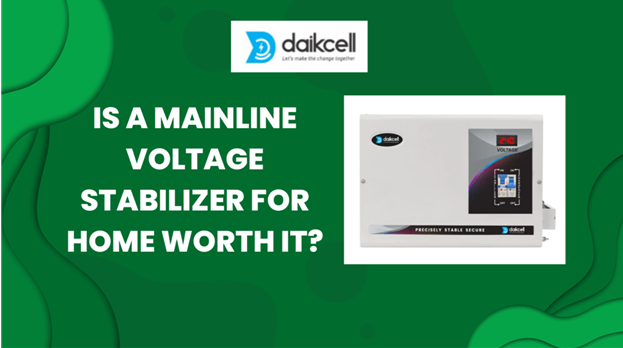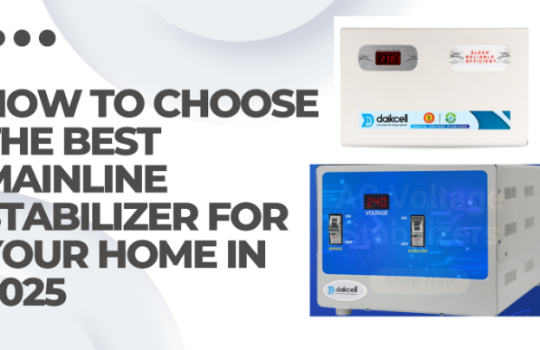Aluminum stabilizer vs. Copper Stabilizer. Which one should I buy and why?

Choosing the right stabilizer for home when picking one to protect your appliances from voltage fluctuation is crucial.
There are stabilizers like the Mainline and Multipurpose ones that serve their own purpose by either protecting your entire household of appliances by connecting to the main power line or safeguarding one appliance from power fluctuations.
But these are functionalities of those types of stabilizers.
What about the types of material they are made of? Does that make a difference? Is there one which is more preferable than the other?
In the Daikcell range of stabilizers, essentially, there are two types, first the aluminum one and second is the copper one.
Although both these types of stabilizers have their own advantages, being informed about how they function and what is the main difference between them can help you make more informed choices when looking for the best stabilizer for your home or office.
Let us deep dive into the world of aluminum and copper stabilizers in this blog.
Key Differences Between Aluminum and Copper Stabilizers
Before we discuss the differences, let us refresh your memory and remind you of the real purpose of any stabilizer, let alone a top-performing one like Daikcell.
A stabilizer is that boon in the shape of a box that safeguards your precious appliances and your home against unwanted and ugly voltage fluctuations. These fluctuations can potentially damage your appliances for good, and while we can’t stop them on our own we sure can take protective measures in the form of a Daikcell stabilizer.
Now let us look at the differences by understanding the pros and cons of an aluminium and a copper stabilizer.

Aluminum Stabilizer:
When talking about the general pros of an Aluminium stabilizer they are:
- Budget-friendly- Daikcell Aluminum stabilizers are known to be notoriously more affordable than their copper counterparts. So if you wish to test the waters with your first stabilizer, an aluminum one, especially a Daikcell aluminum one is what you should go for.
- Lightweight: Thanks to their general properties an aluminum stabilizer is usually lighter than a copper one and is ideal to reduce the load in certain structural setups.
- Can tackle High-Voltage: Daikcell aluminum stabilizers are more suitable for high voltage uses as they can handle higher loads.
Likewise, the cons of an aluminum stabilizer are as follows:
- Low conductivity: Don’t get it wrong, an aluminum stabilizer still gets the job done in a stellar way, it is just that due to its natural properties it does not conduct electricity as well as a copper one would, leading to energy losses.
- Durability concerns: Aluminum stabilizers can be prone to deform under stress, especially when subjected to heavy load or high temperatures, thus, they might not be the ideal choice for high-demand environments like an office setup.

Copper Stabilizer:
Now that we understand what to appreciate and what to look out for in an aluminum stabilizer let us take a look at the copper one:
- Master Conductivity: We know copper itself has excellent electrical conductivity properties. This ensures efficient current distribution and minimum energy loss in any Daikcell copper stabilizers.
- Long-lasting: Copper stabilizers tend to last longer, thanks to copper’s resistance to oxidisation.
- Robust: Daikcell copper stabilizers in comparison to aluminum ones are stronger which means that they do not deform under stress. This reduces the frequency of maintenance and repairs in copper stabilizers.
- Great for Low-Voltage: Daikcell copper stabilizers work better in low voltages due to their conductivity and efficiency. Making them ideal for sensitive appliances.
But wait, it can’t be all good only right? Copper stabilizers also have some cons which are:
- Higher cost: You know how they say good things come with a higer price tag. Although a Daikcell copper stabilizer might be slightly higher in cost you can consider it as an investment in quality and performance.
- Weight consideration: Copper stabilizers are heavier than aluminum ones and might require additional support while installation.
The Daikcell Advantage
Now that we have understood the basic differences between an aluminum and a copper stabilizer let us look at the the top Daikcell range of stabilizers you can choose from.
Daikcell 5 KVA Voltage Stabilizer:
- Copper version: 5 KVA 90V – 300V Heavy Duty Mainline Voltage Stabilizer for Home (Model: DSR016)
- Alumium version: 5 KVA 90V – 300V Heavy Duty Mainline Voltage Stabilizer for Home (Model: DSR015)
Daikcell 10 KVA Voltage Stabilizer:
- Copper version: 10 KVA 90V – 300V Heavy Duty Mainline Voltage Stabilizer for Home (Model: DSR018)
- Aluminum version: 10 KVA 130V – 300V Heavy Duty Mainline Voltage Stabilizer for Home
To conclude while there are downside to both kinds of stabilizers there is no question that Daikcell stabilizers provide the best efficiency and performance without fail whether it is an alumium one or a copper one.








Anish Kumar
April 2, 2025 at 9:20 AMI get some information about stabilizer
daikcell
May 27, 2025 at 10:40 AMContact to the cusotmer care, if you rquried more info